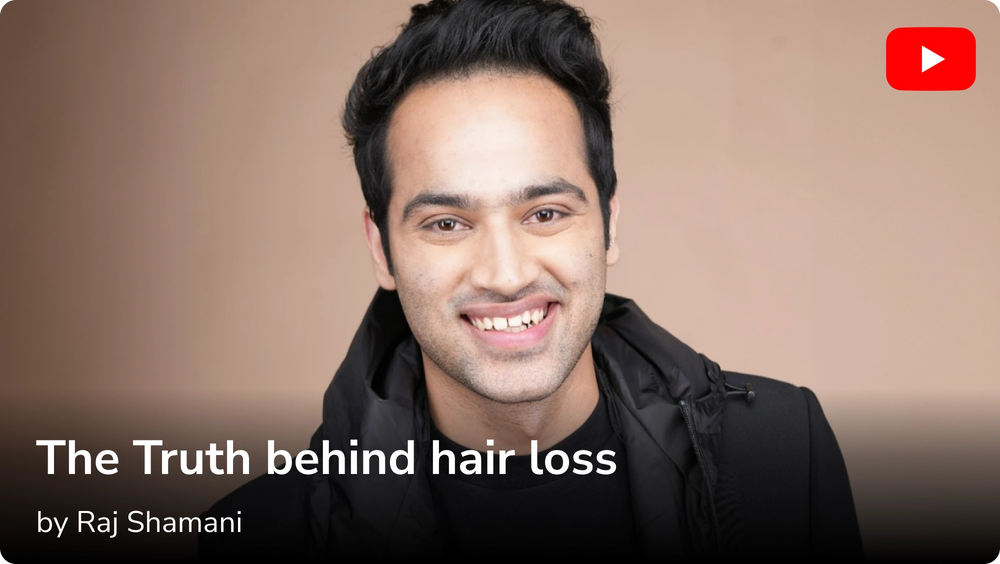Does your hair look like the above image? It is because you have low hair density.
Hair density refers to the number of hair follicles on the scalp and the amount of hair strands present in each area of the scalp. Think of it like this: If you place your hand on one part of your scalp, the “density” would be the number of hair on it. If you feel fewer stands than you would like, you can say you have low hair density (and vice-versa).
Increasing your hair density requires a holistic approach- right from giving your body the important nutrients and hydration it requires to external care with oils, massages and chemical free products, it is a continuous process. Eating foods rich in protein, vitamins and minerals helps with increasing hair density and improving the quality of your hair.

Hair density is a significant factor in determining the fullness and thickness of one's hair. Hair density varies from person to person, and factors such as genetics, age, and overall health can influence it.
Hair density is commonly categorised into three main types: low, medium, and high.
- Thin or low-density hair is characterised by a flat and light appearance, often lacking the volume associated with thicker hair.
- Medium-density hair strikes a balance between the flatness of low-density and the robust fullness of high-density hair. This type showcases a more voluminous and textured look compared to low-density hair.
- High-density hair is often viewed as a symbol of beauty and health. It appears full and thick, with a richness in the number of hair strands present.
Do Genetics matter?
Genetics does play a crucial role in determining hair density, but other factors can impact it, such as hormonal imbalances, nutritional deficiencies, and medical conditions. Nurturing and caring for your unique hair characteristics, whether you have high or low hair density, is important for promoting overall hair health and well-being. “How to increase hair density” is a question that bothers many of us. The answer simple answer is- to identify the cause of low hair density and take steps in the correct direction to promote hair growth. If you wish to find out the cause, you can take a simple Hair Test by Traya that takes just 2 minutes and helps you to improve your hair problem with a personalised kit.
How to Increase Hair Density?
Increasing hair density is not just about external treatments; it starts from within. Alongside the basics, it helps to work on improving sleep quality and managing daily stress levels, as both can quietly impact hair health over time. Additionally, detoxifying the body with hydrating foods like cucumber, coconut water, and citrus fruits supports better nutrient absorption, which is vital for stronger hair follicles.
1. How to increase hair density by food
Apart from the mentioned essentials, don’t overlook the power of seasonal fruits and vegetables. Leafy greens like amaranth and fruits like papaya not only provide vital nutrients but also help in reducing internal heat (Pitta), which is often a hidden contributor to hair thinning. Sprouted legumes like moong and chana are excellent sources of plant-based protein and enzymes that strengthen hair from the inside out. Regular inclusion of these in your meals can make a visible difference over time.
- Protein: Hair is primarily made of protein. Include eggs, lean meats, and legumes for strong and healthy hair.
- Vitamins: Vitamin A promotes sebum production, Vitamin C aids in collagen formation, and Vitamin E acts as an antioxidant. You can include carrots, citrus fruits, and nuts to improve Vitamin A and C levels.
- Minerals: Iron and zinc are crucial for hair growth. Incorporate lean meats, legumes, and seeds to meet these nutritional needs.
- Omega-3 Fatty Acids: In fatty fish, flaxseeds, and walnuts, omega-3s support scalp health and add shine to hair. Omega 3 supplements available in tablets can also be considered viable options.
Also Read: Foods for hair growth.
2. Hydration
Beyond just drinking water, focus on hydrating your body through water-rich foods and natural drinks. Infused water with mint and lemon or coconut water can enhance hydration levels while also providing electrolytes that support scalp health. Hydration is essential not just for the scalp but for keeping the hair shaft flexible and resistant to breakage.
3. Scalp Massage
Enhance your scalp massage by warming the oil slightly before application. Warm oil penetrates better, improving blood flow and nutrient delivery to the follicles. Consistency matters more than intensity, so even 5 minutes daily can yield visible results over a few months. For added benefit, try massaging while doing deep breathing to relax your nervous system, which indirectly supports better hair health.
4. Gentle Hair Care
Let your hair air-dry whenever possible. Excessive towel rubbing can lead to breakage, especially when the hair is wet and fragile. Consider switching to a microfiber towel for gentler drying. Also, avoid brushing wet hair; instead, use a wide-tooth comb once your hair is about 80% dry to prevent unnecessary tugging and breakage.
5. Natural Oils
In addition to coconut, olive, and argan oils, you can explore sesame oil and pumpkin seed oil for their scalp-nourishing benefits. Sesame oil is excellent for improving circulation, while pumpkin seed oil contains natural DHT blockers that can help prevent hair thinning. Applying these oils at night and washing them off the next morning allows deeper penetration and nourishment.
6. Proper Hair Styling
Also, avoid constant use of hair accessories like tight bands and clips, which can cause mechanical damage over time. If you must use styling tools, always keep the heat setting to medium or low and maintain a safe distance from the scalp. Protecting your hair during sleep by using a satin or silk pillowcase can also minimise friction and reduce breakage.
7. Physical activity
Activities like yoga and brisk walking not only boost overall circulation but also help reduce cortisol levels, which is a major trigger for hair fall. Incorporating pranayama (breathing exercises) daily can aid in oxygenating your blood, ensuring that your scalp receives a better supply of nutrients for healthy hair growth.
8. Consider Taking Supplements
Before starting supplements, consult a doctor to understand what your body genuinely lacks. For example, Vitamin D deficiency is common and significantly impacts hair density, but over-supplementing can also be harmful. Traya’s Hair Vitamins, rich in biotin and 18 other essential nutrients, work best when they complement an already balanced diet and lifestyle.
Causes of Low Hair Density
Beyond these causes, chronic inflammation in the body, often caused by unhealthy eating habits and lack of exercise, silently damages hair follicles. Regular detox routines and anti-inflammatory foods like turmeric, ginger, and green leafy vegetables can help counter this. Additionally, hair density can decrease due to unaddressed scalp conditions such as seborrheic dermatitis, so keeping the scalp clean and healthy is crucial.
1. Genetic Factors
Hair loss often has a hereditary factor, with a strong genetic influence on whether an individual will experience thinning hair. If your parents or grandparents had hair density issues, you might also be more prone to it.
2. Hormonal Imbalances
Hormones are critical in regulating various bodily functions, including hair growth. Fluctuations in hormones, particularly during significant life events like menopause or postpartum, can lead to imbalances that result in hair thinning.
3. Medical Treatments
Certain medical treatments, especially chemotherapy, can have the unintended side effect of causing temporary hair loss. While the primary goal of such treatments is to combat illnesses, the impact on hair density can be challenging for many.
4. Stress
The mind-body connection is evident when it comes to stress and hair loss. Both emotional and physical stress can induce a condition known as telogen effluvium, where hair follicles prematurely enter the resting phase, leading to significant hair shedding.
5. Hairstyling Practices
Our daily hairstyling routines can also contribute to low hair density. Tight hairstyles, such as braids or ponytails, and frequent heat treatments can cause traction alopecia, a form of hair loss resulting from continuous tension on the hair shafts.
6. Nutritional Deficiencies
The saying "you are what you eat" also holds for hair health. Inadequate intake of essential nutrients, including vitamins and minerals, can deprive hair follicles of the nourishment they need for optimal growth, contributing to low hair density.
7. Environmental Factors
External elements, such as pollution exposure and harsh weather conditions, can affect our hair health. Pollution, UV rays, and extreme weather can contribute to hair damage and thinning.
8. Underlying Health Conditions
Certain medical conditions, including thyroid disorders and autoimmune diseases, can impact hair density. Addressing the underlying health issue is crucial in managing and potentially reversing hair loss.
When to Seek Expert Advice on Hair Fall
If you notice scalp tenderness, sudden patches of hair loss, or excessive hair in your drain after showers, these are signs to consult an expert immediately. Early diagnosis can help reverse damage before it becomes irreversible. Traya’s Hair Test is designed to catch these signals early, providing a personalised treatment plan that addresses your unique root causes.
If you cannot determine the cause of your hair fall or seek an effective solution, you can take Traya’s free Hair Test to treat hair fall from its root cause.
Conclusion
Improving hair density naturally is all about changing one's lifestyle to create better habits, a proper hair care routine, and a nutrient-rich diet. Initially, it could be difficult to incorporate hair care practices into one’s busy schedule but try to create a system within your day that gives hair care its due space. Focusing on both the internal as well as external aspects affecting hair is the best approach to increasing hair density
Consistency is everything when it comes to increasing hair density naturally. Think of your hair care routine like nurturing a plant — regular watering, sunlight, and nourishment lead to healthy growth over time. Stay patient and trust the process. With small, sustained changes, you will gradually notice fuller, healthier hair.
People Also Ask:
Q. Can Hair Density Be Increased?
Genetic factors primarily determine hair density, and while it's challenging to alter your natural hair thickness significantly, certain measures can enhance the appearance and health of your existing hair. Adopting a healthy lifestyle, proper hair care, and targeted treatments can contribute to fuller-looking hair. However, it's essential to have realistic expectations, as the extent of improvement varies among individuals.
Q. What are the Reasons Behind Reduced Hair Density
Reduced hair density can be attributed to various factors, including genetics, hormonal imbalances, nutritional deficiencies, stress, and environmental influences. Identifying the specific cause is crucial in determining the most effective strategies for addressing and potentially improving hair density. Consultation with a healthcare professional or a dermatologist can help pinpoint the underlying issues and guide a tailored approach.
Q. What are some natural methods for Hair Thickening?
Several natural methods can contribute to the thickening of hair. Regular scalp massages improve blood circulation, promoting healthy hair growth. Natural oils, such as coconut or argan oil, can provide essential nutrients and moisture. Additionally, incorporating herbs like aloe vera or ginseng into your hair care routine may support overall hair health. While these methods may not drastically increase hair density, they can enhance thickness and vitality over time.
Q. How can I get my hair volume back?
Restoring hair volume involves a multifaceted approach. Choosing volumising hair care products, such as shampoos and conditioners, can create the illusion of fuller hair. Proper styling techniques can add lift, like blow-drying with a round brush or using volumising mousse. Regular trims prevent split ends, maintaining the overall health and thickness of the hair. Hair extensions or volumising haircuts can temporarily boost volume for those seeking more immediate results.
Q. How to Increase Hair Density Naturally at Home
Increasing hair density naturally at home involves a combination of lifestyle adjustments and targeted treatments. Adopt a nutrient-rich diet with foods containing vitamins (A, C, E), minerals (iron, zinc), and omega-3 fatty acids. Stay hydrated, manage stress through relaxation techniques, and incorporate scalp massages into your routine to improve blood circulation. Natural remedies like aloe vera gel or onion juice, known for their potential hair-stimulating properties, can be applied topically.
Q. How to Increase Hair Density by Food
Nutrition plays a crucial role in maintaining healthy hair density. Include foods rich in biotin (eggs, nuts), iron (spinach, red meat), omega-3 fatty acids (fatty fish, flaxseeds), and vitamins (fruits and vegetables) in your diet. These nutrients support the hair growth cycle and contribute to overall hair health. Additionally, stay mindful of your protein intake, as hair is primarily protein-based. A well-balanced diet ensures your body receives the essential building blocks for strong and dense hair.
Q: How long does it take to see improvement in hair density?
On average, noticeable improvements take about 3 to 6 months with consistent care and lifestyle changes. However, results vary based on individual health and genetics.
Q: Does scalp exfoliation help increase hair density?
Yes, gentle exfoliation can remove product buildup and dead skin cells, allowing follicles to breathe and grow healthier strands.
Q: Can sleep affect my hair density?
Absolutely. Poor sleep increases cortisol levels, which impacts the hair growth cycle. Aim for 7–8 hours of restful sleep daily for optimal hair health.




















